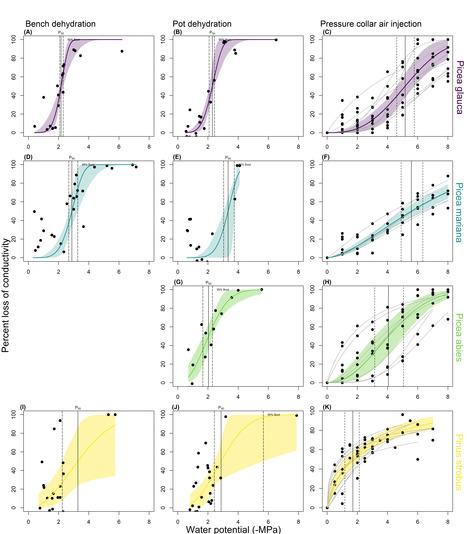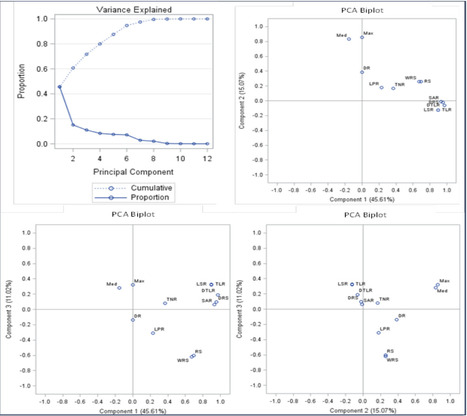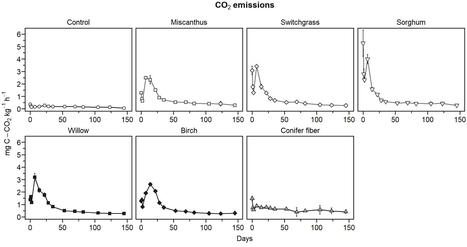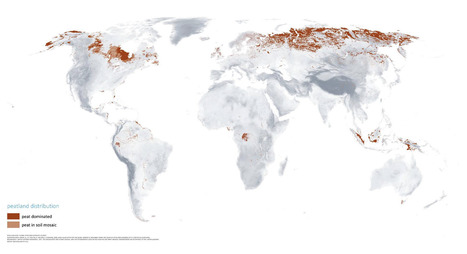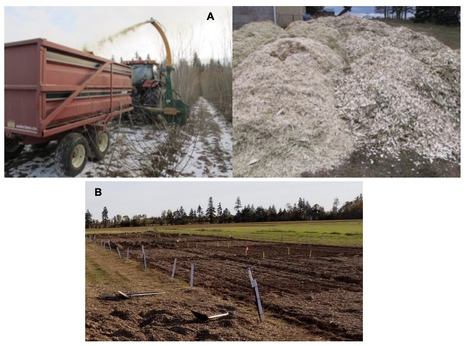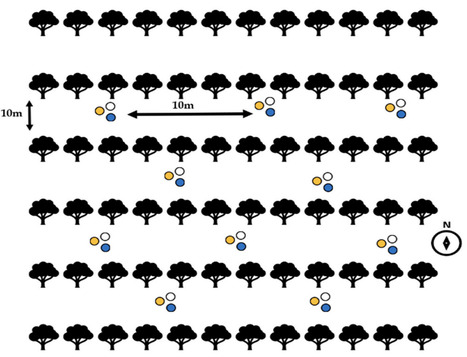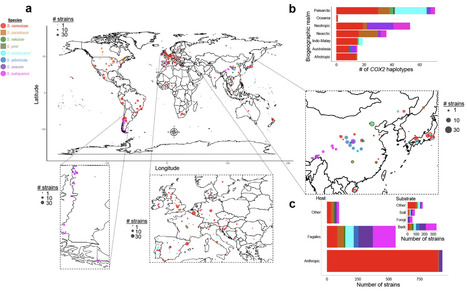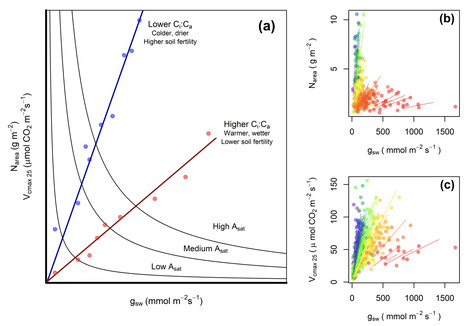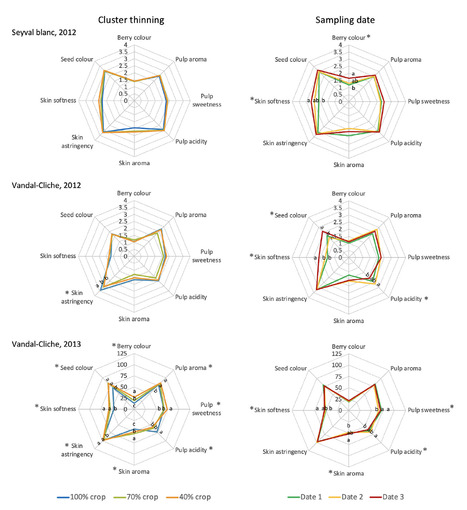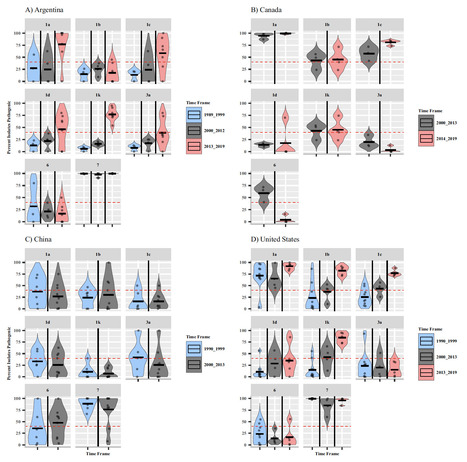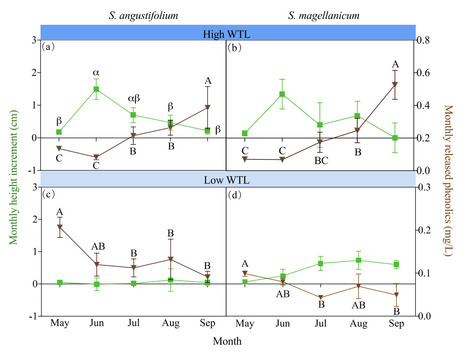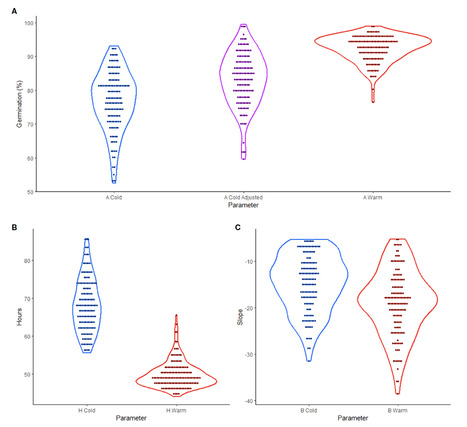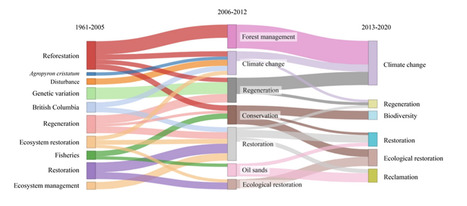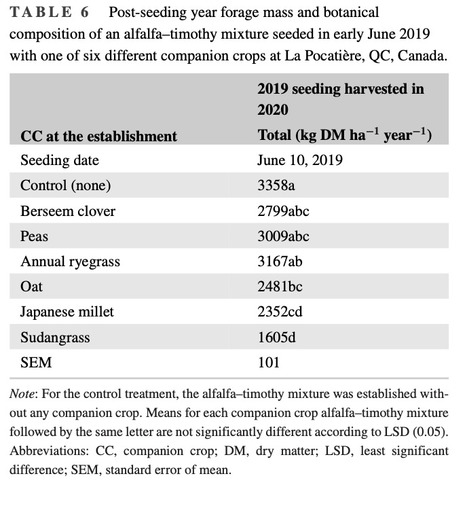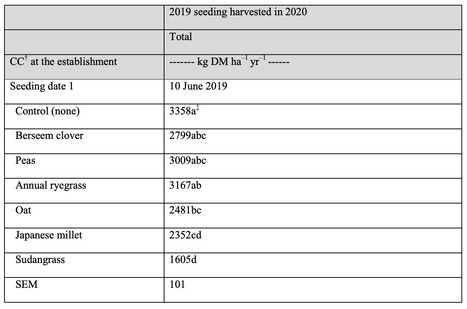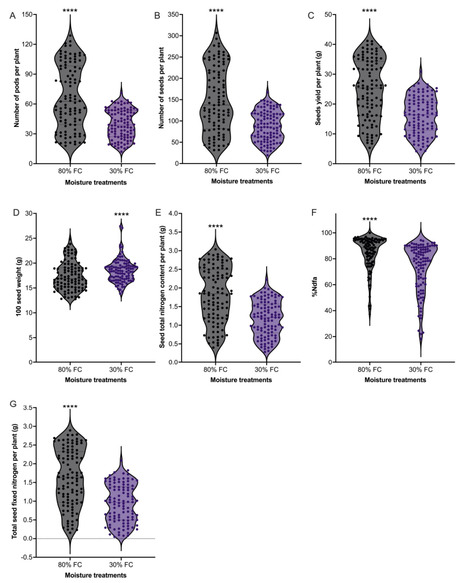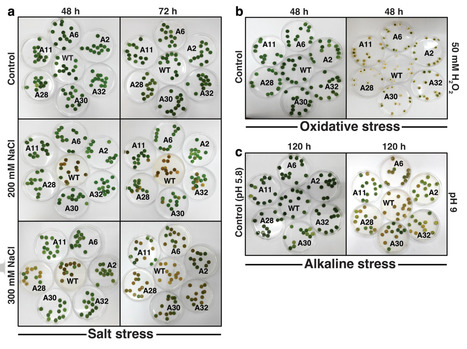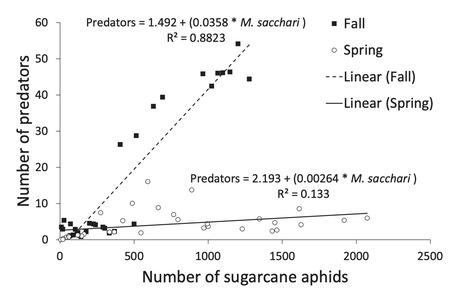 Your new post is loading...
 Your new post is loading...

|
Scooped by
ulcriv
|
The reported study was motivated by the necessity to select 30 soybean lines from a total of 137 for a sophisticated 3-D phenotyping analysis of the Root System Architecture (RSA), which would not allow that all the lines be included and replicated. A representative subset of size 30 was found after performing four cluster analyses and comparing the results of two more particularly. These two cluster analyses are based on the data for 12 RSA-related traits previously collected in 2D on three replicates of the 137 soybean lines and the first six principal components representing 95% of the total dispersion after data standardization in a preliminary Principal Component Analysis (PCA). The two cluster analysis procedures provided 16 soybean lines that were the closest to the centroid of their respective cluster in both cases. Fourteen more were found to be common and at a distance from the centroid below a pre-set threshold value without being the closest. The final selection of 30 excludes two soybean lines that were the second member selected from their cluster, and includes instead two soybean lines that are the closest and second closest to their respective centroid in the cluster analysis after PCA on standardized data, but are not well represented in the other cluster analysis. In conclusion, the 93.3% overlap between the two sets of results shows a robust clustering structure in RSA 2-D phenotyping in soybean. Our statistical approaches and procedures can be followed and applied in other biological frameworks than plant phenotyping.

|
Scooped by
ulcriv
|
Repeated applications of straw and wood chips were recently proposed as a conservation strategy for preserving cultivated peatland carbon (C) stock. However, the variability in the amendment biostability and the possible divergent responses of contrasting peat soils need to be assessed. This study investigated the effect of amendment with different plant materials on carbon dioxide (CO2) emissions from two contrasting peat soils (sapric and hemic) in two laboratory experiments. The sapric soil received one application of plant materials and was incubated for 3190 degree-days (145 days at 22°C), while the hemic soil received three successive applications of plant materials and was incubated for three successive periods of 3150 degree-days (126 days at 25°C). CO2 emissions were measured at time intervals ranging from 2 to 14 days and the apparent proportion of the plant material’s C remaining in the soil was modeled using an exponential decay function. CO2 emissions from the 0-25 cm horizon of the unamended peats represented 0.7 t C-CO2 ha-1 yr-1 in the sapric soil and 7.3, 1.1, and 0.5 t C-CO2 ha-1 yr-1 in the hemic soil for the first, second, and third amendment periods, respectively. The apparent remaining C of the plant material varied from 52% to 81% in the two experiments, resulting in biomass requirements ranging from 2 to 32 t ha-1. The apparent remaining C was from 26% to 36% higher in the sapric soil than in the hemic soil. The apparent remaining C was also 9% to 38% higher for the treated softwoods than the untreated materials (straws: miscanthus, switchgrass, sorghum; wood chips: willow, birch). The repeated application of straw and wood chips increased CO2 emissions in the first 35 days following each application, resulting in an increased decomposition rate for the tested model. However, no change was detected for the final apparent remaining C across the three applications. These findings highlight the importance of considering soil properties, material types, and the impact of repeated applications for designing effective amendment programs and accurate C projection models for cultivated peatlands.

|
Scooped by
ulcriv
|
Peatlands cover only 3–4% of the Earth’s surface, but they store nearly 30% of global soil carbon stock. This significant carbon store is under threat as peatlands continue to be degraded at alarming rates around the world. It has prompted countries worldwide to establish regulations to conserve and reduce emissions from this carbon rich ecosystem. For example, the EU has implemented new rules that mandate sustainable management of peatlands, critical to reaching the goal of carbon neutrality by 2050. However, a lack of information on the extent and condition of peatlands has hindered the development of national policies and restoration efforts. This paper reviews the current state of knowledge on mapping and monitoring peatlands from field sites to the globe and identifies areas where further research is needed. It presents an overview of the different methodologies used to map peatlands in nine countries, which vary in definition of peat soil and peatland, mapping coverage, and mapping detail. Whereas mapping peatlands across the world with only one approach is hardly possible, the paper highlights the need for more consistent approaches within regions having comparable peatland types and climates to inform their protection and urgent restoration. The review further summarises various approaches used for monitoring peatland conditions and functions. These include monitoring at the plot scale for degree of humification and stoichiometric ratio, and proximal sensing such as gamma radiometrics and electromagnetic induction at the field to landscape scale for mapping peat thickness and identifying hotspots for greenhouse gas (GHG) emissions. Remote sensing techniques with passive and active sensors at regional to national scale can help in monitoring subsidence rate, water table, peat moisture, landslides, and GHG emissions. Although the use of water table depth as a proxy for interannual GHG emissions from peatlands has been well established, there is no single remote sensing method or data product yet that has been verified beyond local or regional scales. Broader land-use change and fire monitoring at a global scale may further assist national GHG inventory reporting. Monitoring of peatland conditions to evaluate the success of individual restoration schemes still requires field work to assess local proxies combined with remote sensing and modeling. Long-term monitoring is necessary to draw valid conclusions on revegetation outcomes and associated GHG emissions in rewetted peatlands, as their dynamics are not fully understood at the site level. Monitoring vegetation development and hydrology of restored peatlands is needed as a proxy to assess the return of water and changes in nutrient cycling and biodiversity.

|
Scooped by
ulcriv
|
Nodulin 26-like intrinsic protein (NIP) subfamily of aquaporins (AQPs) in plants, is known to be involved in the uptake of metalloids including boron, germanium (Ge), arsenic (As), and silicon (Si). In the present study, a thorough evaluation of 55 AQPs found in the mungbean genome, including phylogenetic distribution, sequence homology, expression profiling, and structural characterization, contributed to the identification of VrNIP2-1 as a metalloid transporter. The pore-morphology of VrNIP2-1 was studied using molecular dynamics simulation. Interestingly, VrNIP2-1 was found to harbor an aromatic/arginine (ar/R) selectivity filter formed with ASGR amino acids instead of GSGR systematically reported in metalloid transporters (NIP2s) in higher plants. Evaluation of diverse cultivars showed a high level of Si accumulation in leaves indicating functional Si transport in mungbean. In addition, heterologous expression of VrNIP2-1 in yeast revealed As(III) and GeO2 transport activity. Similarly, VrNIP2-1 expression in Xenopus oocytes confirmed its Si transport ability. The metalloid transport activity with unique structural features will be helpful to better understand the solute specificity of NIP2s in mungbean and related pulses. The information provided here will also serve as a basis to improve Si uptake while restricting hazardous metalloids like As in plants.

|
Scooped by
ulcriv
|
Although the evolution of principles, procedures, and predictive abilities related to seedling quality throughout the plant production chain (i.e., from seeds to sustainable plantations) has been reviewed over the past decades in various technical and scientific publications, there is still a need to develop and integrate new and efficient practices in forest nurseries and at planting sites, in order to improve the morphophysiological quality of seedlings and saplings, and their survival and growth under different site and environmental conditions in the context of climate change. We have grouped together different scientific articles in this Special Issue of Forests, entitled “Production in Forest Nurseries and Field Performance of Seedlings”. They cover different topics relating to the seedling production chain in different countries and continents, from growing media to planting performance related to reforestation, restoration, and agroforestry programs.

|
Scooped by
ulcriv
|
Vulnerability curves to cavitation (VC) and their derived parameters, such as P50, are increasingly used and reported to assess forest vulnerability to drought and predict forest responses to climate change. Forest practitioners and policy-makers are encouraged to rely on these parameters to support species selection based on their sensitivity to drought. However, in the majority of studies, we consider that the variability of VC parameters is not clearly reported nor considered, which can lead to counterproductive decisions. In this opinion paper, we demonstrate the importance of precisely reporting the variability around VC parameters and the sources of this variability (plant materials, methods, etc.). We also identify the information that should be provided when reporting mean values of VC parameters. To support our argument, we built VCs for three Picea species and Pinus strobus, using different methods, and compared the value of P50 determined in our experiments with values from a literature review.

|
Scooped by
ulcriv
|
In the Anthropocene it is widely recognized that we need to embrace the concept of sustainable transitions. Strangely, ecological restoration is entirely decoupled from the concept of sustainability transitions. We argue that alongside radical changes in socio-technical systems that define sustainability transitions there will also be a need to conduct extensive ecological restoration. Indeed, that would in and of itself represent a major transition – normalizing ecological restoration where ecosystems that are degraded are restored. We are considering actions needed to have ecological restoration become a part of the radical change that defines sustainability transitions including: Learn and refine as we do restoration; Embrace bold and creative ideas; Adopt a design and systems-thinking approach; View restoration as a complement than a safety net; Work with nature; Create opportunities for massive engagement; Bridge science and practice; Ensure that restoration is equitable and just; Insert restoration into social-technical systems; Invest in restoration and sustainability transitions. Sustainability transitions alone have the potential to limit further ecosystem degradation but will not repair the planet. Similarly, focusing solely on restoration is a losing battle without changing societal relationships with the environment. We conclude that restoration of ecosystems can be done in tandem with sustainability transitions to attain greater and prolonged benefit to achieve a good Anthropocene for the planet and its peoples.

|
Scooped by
ulcriv
|
The future climate of northern temperate forests is projected to be drier and warmer by the end of this century. As a result, more drought-induced forest dieback events are anticipated in northeastern North America, and assessing the vulnerability of dominant tree species to drought is critical for understanding the future composition of these forests. In a greenhouse experiment, we exposed two-year-old seedlings of Picea glauca (Moench) Voss, Picea mariana (Mill.) B.S.P. and Pinus strobus L. to three future climate treatments for southern Quebec, Canada, and evaluated their mortality, growth, and foliage water status responses to soil water availability and atmospheric drought. Using a unique approach, climate treatments emulated droughts of different frequencies, durations, and intensities. Treatments closely simulated one growing season, with changes in air temperature and relative humidity every six hours and daily adjustment in the amount of water delivered to the seedlings. The three species experienced high mortality (75%) in all water-limited treatments compared to a control treatment that provided non-limiting soil moisture (0% mortality). The biomass of the seedlings that survived was 40% lower than that of control seedlings. Our results confirmed that the hydraulic safety margins, defined as the difference between seasonal minimum water potential and xylem water potential leading to 12, 50 and 88% of hydraulic conductivity loss, were good predictors of probability of tree mortality. Therefore, hydraulic safety margins are useful functional traits that can be used to compare the vulnerability of various species to drought and then provide crucial information to practitioners and policymakers to adjust forest management to climate change. We showed that three dominant conifer species of northern temperate forests were highly vulnerable to drought in future climates. Because drought is projected to be a significant threat to forests, understanding potentially adaptive physiological responses to drought, such as hydraulic safety margins of tree seedlings, is important for predicting the response of forest regeneration and composition in warmer and drier climates.

|
Rescooped by
ulcriv
from Originals
|
Potato (Solanum tuberosum L.) crops are often cultivated in coarse-textured soils with low soil organic matter (SOM), and high nitrate leaching risk. Incorporating shrub willow chips into soil could enhance soil properties, while temporally immobilizing N and thus reducing N leaching. We performed a laboratory incubation study and a field experiment to evaluate the effects of shrub willow chips applied at increasing rates in the fall after the potato harvest on C, N and P cycling, soil pH and moisture, and on barley (Hordeum vulgare L.) yield in the following year. In comparison with the control, willow chip incorporation at the rates of 40 Mg ha-1 and 60 Mg ha-1 increased total C content, but it did not affect the activity of C cycling enzymes. Willow chip addition at these rates also induced nitrate immobilization and reduced barley grain yield and total N uptake, but increased the activity of N cycling enzymes (β-1,4-N-acetylglucosaminidase and leucine aminopeptidase). Mehlich-3 extractable P content and phosphomonoesterase activity were not affected by willow chip addition. Our results suggest that shrub willow chips increased total organic C and immobilized N following their incorporation and can thus mitigate nitrate leaching after the potato harvest. The N immobilization was short-lived and was not observed over second winter. We recommend to seed a forage legume in the spring following shrub willow chip incorporation. Willow chip incorporation is an effective means of increasing soil organic carbon.

|
Scooped by
ulcriv
|
Global declines in wild and managed bee populations represent a major concern for the agricultural industry. Such declines result, in part, from the loss of natural and semi-natural habitats in and around agricultural ecosystems. However, remaining forest patches in heavily modified landscapes represent nesting habitats that may be crucial to preserving wild bees and their services. Because wild bees are the main pollinators of fruit crops, preserving potential nesting habitats might be particularly important for the crops’ yield and profitability. Here, we assessed whether the abundance and richness of visiting wild bees in blueberry crops relates to the amount of surrounding forest cover and if so, whether those relationships varied with spatial scale. Specifically, we sampled wild bee communities in 18 blueberry fields during the blooming period in Montérégie, Quebec, Canada, where sampling consisted of pan trap triplets and direct observation of flower visitors on blueberry bushes. Then, we quantified the proportion of forest in radii of 0.5 km, 1 km, and 2 km around each field. Wild bee abundance was positively related to the proportion of forest habitat surrounding the crop field, but the relationship for wild bee richness was less clear. Moreover, these relationships were strongest at 1 and 2 km radii of measured land cover. Overall, pollinator diversity was highest when at least 30% of the surrounding landscape consisted of forest patches, representing a total area of at least 1 km2. Our results suggest that preserving large habitat patches in agricultural landscapes can help prevent further decline in wild bee diversity while maximizing pollination services to fruit crops.

|
Scooped by
ulcriv
|
Species is the fundamental unit to quantify biodiversity. In recent years, the model yeast Saccharomyces cerevisiae has seen an increased number of studies related to its geographical distribution, population structure, and phenotypic diversity. However, seven additional species from the same genus have been less thoroughly studied, which has limited our understanding of the macroevolutionary events leading to the diversification of this genus over the last 20 million years. Here, we show the geographies, hosts, substrates, and phylogenetic relationships for approximately 1,800 Saccharomyces strains, covering the complete genus with unprecedented breadth and depth. We generated and analyzed complete genome sequences of 163 strains and phenotyped 128 phylogenetically diverse strains. This dataset provides insights about genetic and phenotypic diversity within and between species and populations, quantifies reticulation and incomplete lineage sorting, and demonstrates how gene flow and selection have affected traits, such as galactose metabolism. These findings elevate the genus Saccharomyces as a model to understand biodiversity and evolution in microbial eukaryotes.

|
Scooped by
ulcriv
|
Abstract - It is of prime importance to understand feedbacks due to the release of carbon (C) stored in permafrost soils (permafrost-climate feedback) and direct impacts of climatic variations on permafrost dynamics therefore received considerable attention. However, indirect effects of global change, such as the variation in soil nutrient availability and grazing pressure, can alter soil and surface properties of the Arctic tundra, with the potential to modify soil heat transfers toward the permafrost and impact resilience of Arctic ecosystems.
- We determined the potential of nutrients availability and grazing to alter soil energy balance using a 16-year split-plot experiment crossing fertilization at different doses of nitrogen (N) and phosphorus (P) with protection from goose grazing. Moss biomass and some determinants of the surface energy budget (leaf area index (LAI), dead vascular plant biomass and albedo) were quantified and active layer thaw depth repeatedly measured during three growing seasons. We measured soil physical properties and thermal conductivity and used a physical model to link topsoil organic accumulation processes to heat transfer.
- Fertilization increased LAI and albedo, whereas grazing decreased dead vascular plant biomass and albedo. Fertilization increased organic accumulation at the top of the soil leading to drier and more porous topsoil, whereas grazing increased water content of topsoil. As a result, topsoil thermal conductivity was higher in grazed plots than in ungrazed ones. Including these properties into a simulation model, we showed that, after 16 years, nutrient addition tended to shallow the active layer whereas grazing deepened mean July active layer by 3.3 cm relative to ungrazed subplots. As a result of OM accumulation at the surface, fertilization increased permafrost vertical aggradation rate by almost an order of magnitude (up to 5 mm‧year-1 instead of 0.7 mm‧year-1), whereas grazing slowed down permafrost aggradation by reducing surface uprising and deepening thaw depth.
- Synthesis: We demonstrated that long-term grazing and N and P addition, through their impact on vegetation and soil properties have the potential to impact permafrost dynamics to the same extent as contemporary temperature increase in High Arctic polygonal wetlands.

|
Scooped by
ulcriv
|
“Least-cost theory” posits that C3 plants should balance rates of photosynthetic water loss and carboxylation in relation to the relative acquisition and maintenance costs of resources required for these activities. Here we investigated the dependency of photosynthetic traits on climate and soil properties using a new Australia-wide trait dataset spanning 528 species from 67 sites. We tested the hypotheses that plants on relatively cold or dry sites, or on relatively more fertile sites, would typically operate at greater CO2 drawdown (lower ratio of leaf internal to ambient CO2, Ci:Ca) during light-saturated photosynthesis, and at higher leaf N per area (Narea) and higher carboxylation capacity (Vcmax 25) for a given rate of stomatal conductance to water, gsw. These results would be indicative of plants having relatively higher water costs than nutrient costs. In general, our hypotheses were supported. Soil total phosphorus (P) concentration and (more weakly) soil pH exerted positive effects on the Narea-gsw and Vcmax 25-gsw slopes, and negative effects on Ci:Ca. The P effect strengthened when the effect of climate was removed via partial regression. We observed similar trends with increasing soil cation exchange capacity and clay content, which affect soil nutrient availability, and found that soil properties explained similar amounts of variation in the focal traits as climate did. Although climate typically explained more trait variation than soil did, together they explained up to 52% of variation in the slope relationships and soil properties explained up to 30% of the variation in individual traits. Soils influenced photosynthetic traits as well as their coordination. In particular, the influence of soil P likely reflects the Australia's geologically ancient low-relief landscapes with highly leached soils. Least-cost theory provides a valuable framework for understanding trade-offs between resource costs and use in plants, including limiting soil nutrients.
|

|
Scooped by
ulcriv
|
Northern conditions are challenging for grape and wine producers. To cope with these challenges, the use of early ripening interspecific hybrid Vitis sp., such as Seyval blanc and Vandal-Cliche, is often preferred to traditional V. vinifera. However, knowledge about cultural practices suitable for interspecific hybrid varieties are still scarce, especially regarding their impact on profiles of volatile compounds and the sensory perception of berries. In this study, the impact of cluster thinning and harvest date on grapevine physiology, must chemical composition and berry sensory attributes of Seyval blanc and Vandal-Cliche was investigated. Three crop loads (100 %, 70 % and 40 % crop) and three harvest dates corresponding to pre-maturity, maturity, and post-maturity were assessed in 2012 and 2013. Cluster thinning significantly decreased the yield of Vandal-Cliche, but not of Seyval blanc, for which it instead improved fruit set without affecting yield. The impact of cluster thinning on must chemical composition was limited for both cultivars, although some significant changes were observed, especially in the cool season of 2013. Clear variations during ripening, in terms of technological parameters and aroma characteristics, were observed depending on the cultivars and the seasons. In Seyval blanc, C6-alcohols and C13-norisoprenoids decreased during ripening, while C6-aldehydes and linalool increased. In Vandal-Cliche, berries from the first and the last sampling dates of the warm season of 2012 showed the highest levels of C13-norisoprenoids, whereas berries from the last sampling date in the cold season of 2013 showed the highest levels of terpenes, C13-norisoprenoids and ethyl esters. Despite its limited impact on fruit chemical composition, cluster thinning significantly impacted the sensory perception of Vandal-Cliche berries in both years. Cluster-thinned berries had softer skin, sweeter and less acidic pulp, and fruitier skin and pulp aroma. Skin softness allowed excellent discrimination of the maturity of both cultivars during the two study years, suggesting that this descriptor could be a suitable maturity marker for these interspecific hybrid varieties. In summary, cluster thinning proves beneficial for enhancing fruit set in Seyval Blanc in a northern climate; however, its influence on fruit quality is minimal for both cultivars.

|
Scooped by
ulcriv
|
Drained agricultural peatlands are subject to degradation through decomposition, compaction, and erosion. This study aimed to (1) revisit an existing recommendation to systematically apply copper at a rate exceeding crop needs to slow the decomposition of agricultural peatlands, and (2) explore lignosulfonate, a polyphenol, as an alternative method to copper. Two peat soils with contrasting levels of humification (sapric and hemic) and differing Al and Fe contents were studied under controlled conditions. CO2 emissions cumulated in the two unamended soils differed importantly, representing 0.7 and 7.3 t C-CO2 ha−1 yr−1 (0–25 cm) in the sapric and hemic soil, respectively. In the sapric soil, copper did not affect CO2 emissions, N and P parameters, or the activity of most of the measured enzymes. In the same soil, lignosulfonate increased CO2 emissions and phenol oxidase activity, suggesting that the product acted as a microbial substrate. In the hemic soil, copper and lignosulfonate reduced cumulated CO2 emissions by 37 % and 61 %, respectively, as well as N parameters and phosphatase activity. The influence of both treatments on CO2 emissions was, however, temporary. This study suggests limited efficiency of copper and lignosulfonate when applied to soils where underlying mechanisms, such as organic matter recalcitrance and Al and Fe stabilization effect, already regulate decomposition rates. The divergent and temporary effects of copper found in this study and in the literature suggest that routine applications of copper at a rate exceeding crop needs is not consistently effective in slowing decomposition in agricultural peatlands. Lignosulfonate appears to be a promising alternative to copper. The inhibitory effect of polyphenol applications has been demonstrated in natural peatlands but, to our knowledge, this is the first time it has been reported for drained agricultural peatlands. Evaluating the influence of lignosulfonate on other drained agricultural peat soils and under field conditions is necessary to determine the potential of this approach.

|
Scooped by
ulcriv
|
Plant disease resistance genes are widely used in agriculture to reduce disease outbreaks and epidemics and ensure global food security. In soybean, Rps (Resistance to Phytophthora sojae) genes are used to manage Phytophthora sojae, a major oomycete pathogen that causes Phytophthora stem and root rot (PRR) worldwide. This study aims to identify temporal changes in P. sojae pathotype complexity, diversity, and Rps gene efficacy. Pathotype data was collected from 5121 isolates of P. sojae, derived from 29 surveys conducted between 1990 and 2019 across the United States, Argentina, Canada, and China. This systematic review shows a loss of efficacy of specific Rps genes utilized for disease management and a significant increase in the pathotype diversity of isolates over time. This study finds that the most widely deployed Rps genes used to manage PRR globally, Rps1a, Rps1c and Rps1k, are no longer effective for PRR management in the United States, Argentina, and Canada. This systematic review emphasizes the need to widely introduce new sources of resistance to P. sojae, such as Rps3a, Rps6, or Rps11, into commercial cultivars to effectively manage PRR going forward. Rps genes are used to manage the major soybean pathogen Phytophthora sojae, which causes Phytophthora stem and root rot (PRR). Here, the authors show that widely used Rps genes are no longer effective for managing PRR in the United States, Canada and Argentina.

|
Scooped by
ulcriv
|
Background Cultivated peatlands are widespread in temperate and boreal climate zones. For example, in Europe about 15% of the pristine peatland area have been lost through drainage for agricultural use. When drained, these organic soils are a significant source of greenhouse gas (GHG) emissions. To reach climate goals, the agricultural sector must reduce its GHG emissions, and one measure that has been discussed is changing land use from cropland to ley production or perennial green fallow. This management change leads to lower reported emissions, at least when using the IPCC default emission factors (EF) for croplands and grasslands on organic soils (IPCC 2014). However, there was a limited background dataset available for developing the EFs, and other variables than management affect the comparison of the land use options when the data originates from varying sites and years. Thus, the implications for future policies remain uncertain. This protocol describes the methodology to conduct a systematic review to answer the question of whether ley production or perennial green fallow can be suggested as a valid alternative to annual cropping to decrease GHG emissions on organic soils in temperate and boreal climate. Methods Publications will be searched in different databases and bibliographies of relevant review articles. The comprehensiveness of the search will be tested through a list of benchmark articles identified by the protocol development team. The screening will be performed at title and abstract level and at full text level, including repeatability tests. Eligible populations are organic agricultural soils in temperate and boreal climate regions. Interventions are grasslands without tillage for at least 3 years, and comparators are annual cropping systems within the same study as the intervention. The outcome must be gas fluxes of either carbon dioxide (CO2), nitrous oxide (N2O), or methane (CH4), or any combination of these gases. Studies will go through critical appraisal, checking for internal and external validity, and finally data extraction. If possible, a meta-analysis about the climate impact of perennial green fallow compared to annual cropping on organic soils will be performed.

|
Scooped by
ulcriv
|
Monthly variation in accumulation and release of phenolics in bryophytes and their allelopathic effects are little known despite their ecological significance. We conducted a field transplant experiment, to investigate Sphagnum growth and extracellular enzymes that modulate phenolic contents and release along water table level (WTL) gradient. Specifically, we assessed monthly changes in height increment, phenolic release and allelopathic effect during the growing season, as well as extracellular enzymes at the end of the experiment, for the two Sphagnum species: S. angustifolium, a hollow dwelling species, and S. magellanicum, a hummock species. Both Sphagnum species showed season- and WTL-dependent height increment and released phenolics. Sphagnum angustifolium exhibited negative allelopathy regardless of WTL, while S. magellanicum demonstrated mainly positive allelopathy at high WTL and negative allelopathy at low WTL. The degree of allelopathy was not contingent on phenolic release, but phenolic production was negatively correlated with height growth of the two species at their atypical habitats. Moreover, phenoloxidase or peroxidase did not show high activity at low WTL compared to high WTL. Our findings demonstrate for the first time that the strength and direction of allelopathy in Sphagnum may vary depending on the growing precipitation and temperature, WTL and inter- and intraspecific trait variability. Longer-term experiments may further elucidate the seasonal dynamics and mechanism of Sphagnum allelopathy.

|
Scooped by
ulcriv
|
In Canada, the length of the frost-free season necessitates planting crops as early as possible to ensure that the plants have enough time to reach full maturity before they are harvested. Early planting carries inherent risks of cold water imbibition (specifically less than 4°C) affecting seed germination. A marker dataset developed for a previously identified Canadian soybean GWAS panel was leveraged to investigate the effect of cold water imbibition on germination. Seed from a panel of 137 soybean elite cultivars, grown in the field at Ottawa, ON, over three years, were placed on filter paper in petri dishes and allowed to imbibe water for 16 hours at either 4°C or 20°C prior to being transferred to a constant 20°C. Observations on seed germination, defined as the presence of a 1 cm radicle, were done from day two to seven. A three-parameter exponential rise to a maximum equation (3PERM) was fitted to estimate germination, time to the one-half maximum germination, and germination uniformity for each cultivar. Genotype-by-sequencing was used to identify SNPs in 137 soybean lines, and using genome-wide association studies (GWAS - rMVP R package, with GLM, MLM, and FarmCPU as methods), haplotype block analysis, and assumed linkage blocks of ±100 kbp, a threshold for significance was established using the qvalue package in R, and five significant SNPs were identified on chromosomes 1, 3, 4, 6, and 13 for maximum germination after cold water imbibition. Percent o

|
Scooped by
ulcriv
|
Much has been achieved by research into ecological restoration as a nature-based solution to the destruction of ecosystems, particularly in Canada. We conducted a national-level synthesis of Canadian restoration ecology research to understand strengths and gaps. This synthesis answers the following questions: Who is studying restoration? What ecosystem types are studied? Where is restoration studied? Which themes has restoration research focused on? Why is restoration happening? And how is restoration monitored and evaluated? We employed systematic searching for this review. Our results show that restoration research is conducted mainly by academics. Forest, peatland, grassland, and lake ecosystem types were the most commonly studied. There was a concentration of research in four provinces (Ontario, Quebec, Alberta, and British Columbia). Research into restoration has changed its thematic focus over time from reforestation to climate change. Legislation was the most common reason given for restoration. Restoration research frequently documented results of less than 5 years of monitoring and included one category of response variable (e.g., plant response but not animal response). Future research could investigate the outcomes of restoration prompted by legislation. At the dawn of the UN Decade on Ecosystem Restoration, this work demonstrates Canada's momentum and provides a model for synthesis in other countries.

|
Scooped by
ulcriv
|
Oat (Avena sativa L.) is the main species used as a companion crop when establishing perennial forages in eastern Canada, and, although other annual species are used, they have not been systematically evaluated. A field study was conducted across five environments to contrast the use of six annual species (berseem clover, Trifolium alexandrinum L.; forage peas, Pisum sativum L.; annual ryegrass, Lolium multiflorum Lamarck; oat; Japanese millet, Echinochloa esculenta [A. Braun] H. Scholz; sudangrass, Sorghum × drummondii [Nees ex. Steud.] Millsp. & Chase) as companion crops for the establishment of alfalfa (Medicago sativa L.)-timothy (Phleum pratense L.) mixtures. The control treatment consisted of the perennial species seeded without companion crop. Treatments were seeded at three dates and evaluated during the seeding and post-seeding years. The performance of the six companion crops evaluated herein varied depending on the seeding date and the environment. For a mid-May to early June seeding total seeding year forage mass was greatest with use of oat, Japanese millet, or sudangrass as companion crops; for a mid-June to late June seeding with Japanese millet or sudangrass; and for a late July to early August seeding with oat or Japanese millet. These species, however, reduced in some environments seeding year alfalfa or timothy mass compared to a control seeded without a companion crop. Such reduction was also observed in some environments in the first post-seeding year. Companion crop choice to establish alfalfa–timothy mixtures needs to take into consideration seeding date and forage needs on the short term versus the long term.

|
Scooped by
ulcriv
|
Oat (Avena sativa L.) is the main species used as a companion crop when establishing perennial forages in eastern Canada, and, although other annual species are used, they have not been systematically evaluated. A field study was conducted across five environments to contrast the use of six annual species [berseem clover, Trifolium alexandrinum L.; forage peas, Pisum sativum L.; annual ryegrass, Lolium multiflorum Lamarck; oat; Japanese millet, Echinochloa esculenta (A. Braun) H. Scholz; sudangrass, Sorghum × drummondii (Nees ex. Steud.) Millsp. & Chase] as companion crops for the establishment of alfalfa (Medicago sativa L.)-timothy (Phleum pratense L.) mixtures. The control treatment consisted of the perennial species seeded without companion crop. Treatments were seeded at three dates and evaluated during the seeding and post-seeding years. The performance of the six companion crops evaluated herein varied depending on the seeding date and the environment. For a mid-May to early-June seeding total seeding year forage mass was greatest with use of oat, Japanese millet, or sudangrass as companion crops; for a mid- to late-June seeding with Japanese millet or sudangrass; and for a late- July to early -August seeding with oat or Japanese millet. These species, however, reduced in some environments seeding year alfalfa or timothy mass compared to a control seeded without a companion crop. Such reduction was also observed in some environments in the first post-seeding year. Companion crop choice to establish alfalfa-timothy mixtures needs to take into consideration seeding date and forage needs on the short- versus the long-term.Cliquez ici pour éditer le contenu

|
Scooped by
ulcriv
|
Soybean fixes atmospheric nitrogen through the symbiotic rhizobia bacteria that inhabit root nodules. Drought stress negatively affect symbiotic nitrogen fixation (SNF) in soybean. The main objective of this study was to identify allelic variations associated with SNF in short-season Canadian soybean varieties under drought stress. A diversity panel of 103 early-maturity Canadian soybean varieties was evaluated under greenhouse conditions to determine SNF-related traits under drought stress. Drought was imposed after three weeks of plant growth, where plants were maintained at 30% field capacity (FC) (drought) and 80% FC (well-watered) until seed maturity. Under drought stress, soybean plants had lower seed yield, yield components, seed nitrogen content, % nitrogen derived from the atmosphere (%Ndfa), and total seed nitrogen fixed compared to those under well-watered conditions. Significant genotypic variability among soybean varieties was found for yield, yield parameters, and nitrogen fixation traits. A genome-wide association study (GWAS) was conducted using 2.16 M single nucleotide single nucleotide polymorphisms (SNPs) for different yield and nitrogen fixation related parameters for 30% FC and their relative performance (30% FC/80% FC). In total, five quantitative trait locus (QTL) regions, including candidate genes, were detected as significantly associated with %Ndfa under drought stress and relative performance. These genes can potentially aid in future breeding efforts to develop drought-resistant soybean varieties.

|
Scooped by
ulcriv
|
Under field conditions, plants are often simultaneously exposed to several abiotic and biotic stresses resulting in significant reductions in growth and yield; thus, developing a multi-stress tolerant variety is imperative. Previously, we reported the neofunctionalization of a novel PNP family protein, Putranjiva roxburghii purine nucleoside phosphorylase (PRpnp) to trypsin inhibitor to cater to the needs of plant defense. However, to date, no study has revealed the potential role and mechanism of either member of this protein group in plant defense. Here, we overexpressed PRpnp in Citrus aurantifolia which showed nuclear-cytoplasmic localization, where it functions in maintaining the intracellular purine reservoir. Overexpression of PRpnp significantly enhanced tolerance to salt, oxidative stress, alkaline pH, drought, and two pests, Papilio demoleus and Scirtothrips citri in transgenic plants. Global gene expression studies revealed that PRpnp overexpression up-regulated differentially expressed genes (DEGs) related to ABA- and JA- biosynthesis and signaling, plant defense, growth, and development. LC-MS/MS analysis validated higher endogenous ABA and JA accumulation in transgenic plants. Taken together, our results suggest that PRpnp functions by enhancing the endogenous ABA and JA, which interact synergistically and it also inhibits trypsin proteases in the insect gut. Also, like other purine salvage genes, PRpnp also regulates CK metabolism and increases the levels of CK-free bases in transgenic Mexican lime. We also suggest that PRpnp can be used as a potential candidate to develop new varieties with improved plant vigor and enhanced multiple stress resistance.

|
Scooped by
ulcriv
|
To determine the factors leading to outbreaks of the sugarcane aphid, Melanaphis sacchari, (Zehntner) (Hemiptera: Aphididae) in sorghum in Haiti, a survey was carried out on farms during two cropping seasons, spring and fall of 2018. A total of 45 plots in three Haitian regions were monitored from the five-leaf stage to grain ripening. Infestation with M. sacchari was significantly higher in spring than in fall, except in one location. Melanaphis sacchari populations varied significantly according to phenological stages of sorghum, with significantly higher abundance during the heading and flowering stages than other stages. In and around sorghum fields, the sugarcane aphid was observed on plants from three families: Poaceae, Malvaceae, and Cucurbitaceae. Aphid natural enemies found in sorghum fields consisted of eight species of ladybeetles (Coleoptera: Coccinellidae), one hoverfly (Diptera: Syrphidae), one lacewing (Neuroptera: Chrysopidae), and one predatory midge (Diptera: Cecidomyiidae). In addition to these predators, two parasitoid species, Adialytus sp. (Hymenoptera: Braconidae) and Pachyneuron aphidis (Bouché) (Hymenoptera: Pteromalidae), emerged from sugarcane aphid mummies. Predator and parasitoid densities were highly affected by growing season, with most of the biological control happening in fall. This study provides insights on sugarcane aphid management in Haiti and the Caribbean Islands.
|


 Your new post is loading...
Your new post is loading...
 Your new post is loading...
Your new post is loading...


